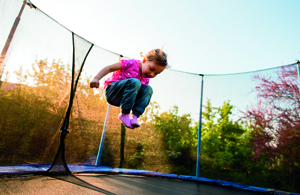Balancing the fun and dangers of trampolines
5/22/2025 by Paige Partain, M.D.

Balancing a child’s fun and safety presents a key parenting challenge. Trampolines are a perfect example of this dilemma. When it comes to trampoline use for kids, are we overreacting, or is there a significant risk of injury?
Since 1977, the American Academy of Pediatrics (AAP) has been making safety recommendations for trampolines. Given the relatively high risk of injury, the AAP currently recommends keeping kids away from trampolines, except in settings where they have close monitoring with professional coaches or on specialized equipment. Despite this recommendation, trampoline popularity is increasing, so parents will likely have to contend with deciding whether to let their child jump or not.
The dangers
Trampoline injuries can range from minor (such as sprains or bruises) to more severe (including broken bones, concussions, and even permanent injuries from head, neck, or spinal trauma). One nationwide surveillance system counted over 800,000 pediatric injuries in the 2009–2018 time frame, with a majority of injuries (54%) occurring on a trampoline at a child’s own home.
So, what are the dangers and types of injuries from playing on trampolines?
- The most common injuries are typically fractures, sprains/strains, and bruises or scrapes.
- Multiple people jumping simultaneously accounts for approximately 75% of injuries.
- Children ages 2-12 years seem to have the highest risk of getting hurt. Compared to adolescents, younger children are more likely to sustain internal injuries or dangerous internal bleeding as a result of trampoline accidents.
- Falls account for about one-third of injuries. Arms are most commonly injured after a fall, and about 60% are fractures.
- Head and neck injuries account for up to 17% of injuries. The most severe are caused by doing a somersault or the child falling from the trampoline and landing on their head or neck.
Manufacturers have been trying to improve trampoline construction and safety, including netting and padding around trampolines. Surprisingly, current evidence doesn't show that these additions have led to a significant decrease in injuries. Unfortunately, the trampoline mat is still the culprit for various injuries.
The balance
Jumping on a trampoline is still a lot of fun, so it's up to every parent to decide what amount of risk they can tolerate when balancing fun and safety. The good news is that the risk of injury can be reduced by following a few trampoline safety rules:
- Only one jumper at a time on the trampoline.
- No somersaults allowed.
- An adult should supervise at all times.
- Children younger than six aren't allowed to jump on the trampoline.
- Adequate protective padding and a netted enclosure should be required.
Set up on level ground away from trees, patios, yard furniture, play equipment, etc. Also, check your homeowner's policy to see if additional coverage is required for trampoline-related injuries if you have one on your property.
For more information, check out "Are Trampolines Safe for Kids?" published at www.healthychildren.org.
Paige Partain, M.D., is a general pediatrician in Community Pediatric and Adolescent Medicine (CPAM) and practices at Mayo Family Clinic Northeast. She completed her medical degree at the University of Alabama and pediatric residency at the Mayo Clinic in Rochester, Minnesota.
